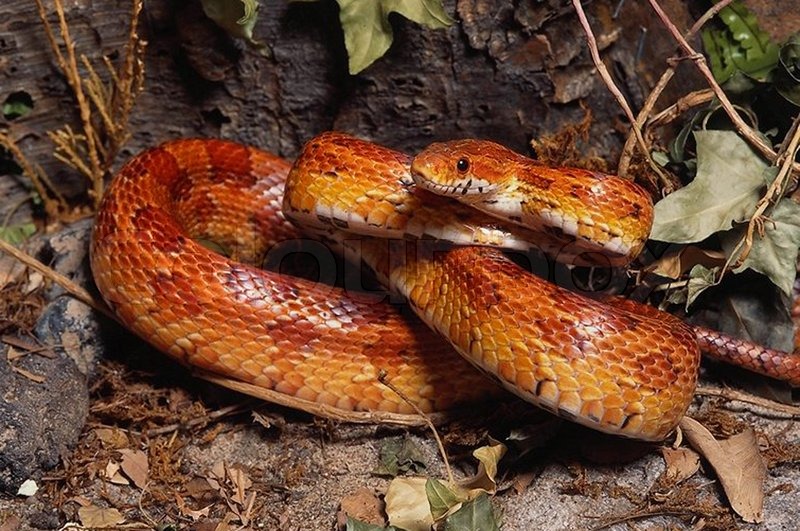ANIMAL: Corn Snake/Red Ratsnake Pantherophis guttatus Type of Animal: Colubrid Habitat: Overgrown fields, forest openings, trees, palmetto flatwoods, farmland, abandoned buildings, barns, wooded groves, rocky hillsides, meadowlands, woodlots, pine rockland, rockland hammocks, mangrove forest, urban/suburban areas, forests, woodlands Location(s): S.E. U.S. from New Jersey to Florida Keys & as west as E. Texas. Introduced in Bahamas (New Providence & Grand Bahama), Grand Cayman, St. Thomas, & Lesser Antilles. Appearance: Come in many different color morphs, some orangish-reddish w/ black lines, some very light red w/ white spots, some grayish-brownish, some albinos. Most besides albinos have yellow pigment. Food/Diet: Rats, mice, squirrels, bats, birds, small lizards, young snakes, frogs, invertebrates, fish Status in Wild: Stable Conservation: Breeding from zoos & private breeders. Very common in pet trade. Lifestyle: Solitary Additional Info: Called: Male Female Young-Snakelet Group-Solitary Weight: Male-11.2 oz Female-14.4 oz Young-1.28 oz Gestation: 1 month Body Length: Male-4 ft Female-5 ft Young-0.75-1.16 ft Life Span: 10-12 years in wild, up to 23 years in captivity Tail Length: Male-7.2 in Female-6 in Young-1.2-4.32 in Main predators of adults are pigs, crocodilians, bears, raptors, larger snakes, coyotes, foxes, domestic/feral dogs, raccoons, bobcats, domestic/feral cats, skunks, corvids, herons, cranes, storks, & egrets. Rats & adult corn snakes prey on young. They kill prey by constriction, since they’re not venomous. Usually breed in spring. Usually diurnal but in hotter weather will become crepuscular or nocturnal. Sexually mature at 1.5-2 years old. Warmer egg temperatures usually result in males while cooler egg temperatures usually result in females. Hibernate in winter. Like many snakes, they’re rather secretive in the wild. Females can lay anything from 5-40 eggs per clutch. They eat every couple of days. Sexually mature at 1.5 years. Eggs usually deposited in rotting stump or pile of decaying vegetation. Fun Fact(s): Name derives from checkered patterned look of Indian corn on scales. Very common in pet trade due to easiness of keeping & placid temperament. Sometimes killed due to being mistaken for venomous copperhead. Many farmers like these snakes because they kill rodents.
